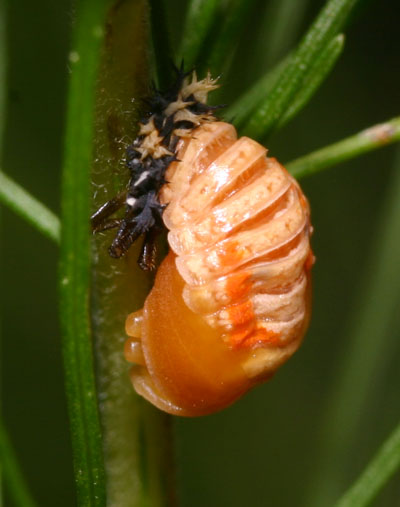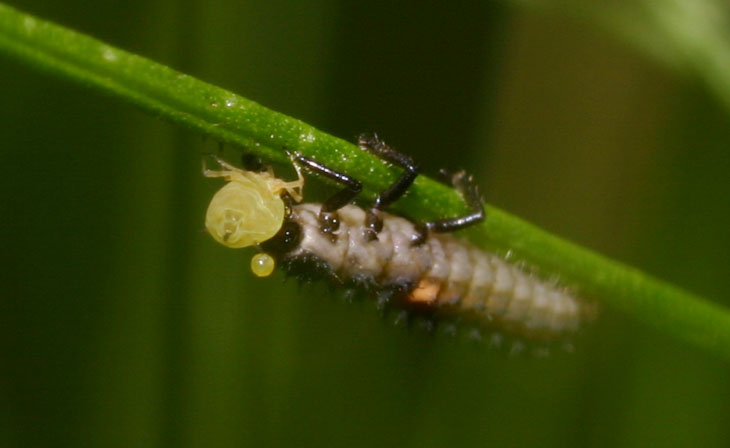In all seriousness, I don’t strictly photograph bugs, and I’m more than happy to do some mammals and cute critters, but I haven’t been coming across many recently. I’ll dig through older slides for something furry pretty soon, I promise.

 But even when I tackle the “cuter” bugs, the bare truth is, they’re not always cute. The insects known most often here as “ladybugs” (or “ladybirds” in Canada and the UK) are, as you may already have heard, not “bugs.” The distinction is important to entomologists but sometimes annoying to everyone else, who find that the only term that really applies to the vast range of crawly animals is “arthropods,” and that really doesn’t cut it. Even “insects” doesn’t apply to arachnids and such. Anyway, just recently I managed to photograph all stages of the lady beetle class of icks, the family of Coccinellidae. The specimen in my opening image at top is probably a spotless lady beetle (Cycloneda sanguinea,) but I cannot guarantee the identification of the remaining images, despite all of them being taken within a half meter. Several very similar species may share the same space, and even variations within the same species can make identification somewhat questionable. Rather than imply anything misleading, I’m simply going with the only detail I’m sure of, which is the family.
But even when I tackle the “cuter” bugs, the bare truth is, they’re not always cute. The insects known most often here as “ladybugs” (or “ladybirds” in Canada and the UK) are, as you may already have heard, not “bugs.” The distinction is important to entomologists but sometimes annoying to everyone else, who find that the only term that really applies to the vast range of crawly animals is “arthropods,” and that really doesn’t cut it. Even “insects” doesn’t apply to arachnids and such. Anyway, just recently I managed to photograph all stages of the lady beetle class of icks, the family of Coccinellidae. The specimen in my opening image at top is probably a spotless lady beetle (Cycloneda sanguinea,) but I cannot guarantee the identification of the remaining images, despite all of them being taken within a half meter. Several very similar species may share the same space, and even variations within the same species can make identification somewhat questionable. Rather than imply anything misleading, I’m simply going with the only detail I’m sure of, which is the family.
 It started with finding the eggs on a dog fennel plant (Eupatorium capillifolium) in the yard. I had no idea what they were. I tried to keep an eye on them, but they still hatched while I wasn’t available, producing not the caterpillars that I expected, but rather nasty-looking spiky black larva that looked like something from The Road Warrior. These spent a few days clustered about the empty egg cases, which you may note have lost all of their color. Like the chrysalises of the monarch butterfly, the eggshells were actually clear; the color was provided by the developing occupants, which very likely hatched in that color but turned black as their exoskeletons dried and hardened – I have seen the same with several other species of arthropod, such as assassin bugs.
It started with finding the eggs on a dog fennel plant (Eupatorium capillifolium) in the yard. I had no idea what they were. I tried to keep an eye on them, but they still hatched while I wasn’t available, producing not the caterpillars that I expected, but rather nasty-looking spiky black larva that looked like something from The Road Warrior. These spent a few days clustered about the empty egg cases, which you may note have lost all of their color. Like the chrysalises of the monarch butterfly, the eggshells were actually clear; the color was provided by the developing occupants, which very likely hatched in that color but turned black as their exoskeletons dried and hardened – I have seen the same with several other species of arthropod, such as assassin bugs.

After a few days the larvae spread out and could be found in numerous locations on the plant, starting to develop orange spots on their abdomens. Their body length as of this image was somewhere in the range of 4-6mm, so the aphid that it has seized as food was apparent to me, in the viewfinder, only as a green dot. Bear in mind that this was probably twice the length it had been when newly hatched, so I’m guessing this isn’t the first aphid to fall under its mighty mouthparts. And with the development of the coloration, I now recognized this as a species I’d seen before, yet never tried to identify. A larger version had been spotted on the same plant only a few days earlier.
 That larger version was what finally clued me in to what species I was seeing develop. In those same few days, it had gone from a fatter version of the feeding larva above to this, which is the pupa form (the head is at top.) Now, the adult coloration and shape has started to develop, and a quick web search on the lady beetle life cycle confirmed my suspicions. The pupa here will soon molt its exoskeleton and produce the wings and elytra (wing shells) that we’re all familiar with. In fact, just a day after this image, the same pupa has started to produce spots. I’m hoping to have better luck catching the emergence of the adult, but we’ll see what happens.
That larger version was what finally clued me in to what species I was seeing develop. In those same few days, it had gone from a fatter version of the feeding larva above to this, which is the pupa form (the head is at top.) Now, the adult coloration and shape has started to develop, and a quick web search on the lady beetle life cycle confirmed my suspicions. The pupa here will soon molt its exoskeleton and produce the wings and elytra (wing shells) that we’re all familiar with. In fact, just a day after this image, the same pupa has started to produce spots. I’m hoping to have better luck catching the emergence of the adult, but we’ll see what happens.
Some trivia. Most flying arthropods demonstrate the presence of two pairs of wings, or at least the common ancestry of such. Dragonflies are among those that still possess both pairs, while many other flying insects have only vestigial remnants, resembling tiny clubs, that may act as counterbalances. For beetles, however, the front pair of wings evolved into hard shells that both protect the folded hind wings, which still provide flight, and also produce useful coloration.
The useful coloration in this case is the vibrant and contrasty pattern that tells predators to keep away. I’ve mentioned aposematic coloring before, and for lady beetles, it’s connected with a nasty taste, from a chemical apparently exuded from their knees – yeah, that’s on my shooting list. Such insects not only fail to achieve camouflage, they’re actually about as far from it as they can be short of shooting off fireworks; the theory maintains that this distinctiveness makes them more memorable to species that tried to pop one down and almost tossed their cookies, just like anyone that’s tried Vegemite is quite wary of greasy brown spreads now.
I leave you with one last image, another view of the feeding larva above. You can see that the poor defenseless aphid has nevertheless scored a victory of sorts; I admit to some satisfaction at the thought, faced with being eaten, of at least shitting on my nemesis’ head. And of course it’s much better if pics of it get posted online.





















































